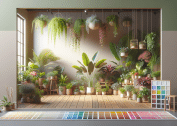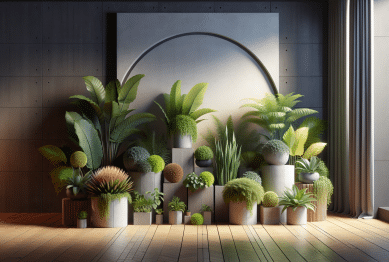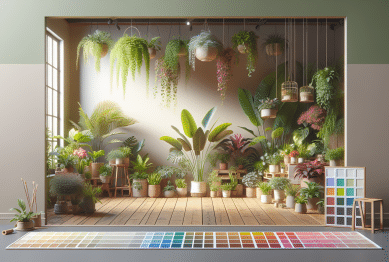Curious about transforming a compact outdoor area? Explore how small space gardens can feel abundant with clever vertical gardening ideas, container plantings, and strategic design. Dive into practical solutions that maximize every inch of your home and garden.
Why Small Space Gardens Deserve Attention
Small space gardening unlocks joy and creativity in homes with limited outdoor areas. Whether a balcony, tiny patio, or petite yard, maximizing garden potential brings color and relaxation close. Many people discover that small gardens often require less maintenance while providing opportunities for beautiful, functional results. By carefully planning your layout, choosing space-saving planters, or focusing on compact varieties, a small garden becomes a flourishing retreat. Container gardening has surged in popularity for these reasons—it’s flexible, movable, and ideal even if your only garden is a windowsill.
Compact gardens simplify routines but offer surprising abundance. They encourage selecting high-yield, compact vegetable varieties or dwarf ornamental shrubs—perfect for urban settings. When every square foot counts, decisions about what to grow become more thoughtful. Vertical gardening also comes into play, enabling upward growth to compensate for shallow ground space. Even flowers thrive on trellises, walls, or creative structures built for climbing plants.
Benefits go beyond beauty. Small gardens can improve mental well-being by providing a green view and daily access to nature, even in dense cities. Evidence suggests that tending plants, no matter how limited the space, can lower stress and boost mood. Plus, efficient gardening systems in small spaces may use less water and soil resources, making them eco-friendly options for sustainable living (Source: https://www.fs.usda.gov/Internet/FSE_DOCUMENTS/stelprdb5368392.pdf).
Creative Vertical Gardening Solutions
Vertical gardening transforms narrow or crowded spaces. With smart vertical plant walls or stacked containers, even blank fences or balcony railings become productive. Popular practices include using modular shelving, hanging pockets, tiered pot stands, and even recycled storage solutions. These systems fit herbs, lettuce, strawberries, and flowers—generating lush displays from the ground up while freeing valuable square footage for other uses.
Some plants naturally thrive in vertical systems. Trailing varieties such as sweet potato vine, cascading petunias, and string-of-pearls drape attractively, while creeping Jenny or thyme form living ‘curtains’ along the edges. Meanwhile, climbing edibles like beans, peas, and cucumbers scale wire frames or trellises easily, giving the added benefit of shade or privacy screens. Mixing different plant types creates a tapestry of foliage and texture, further enhancing the vertical garden’s charm.
Structural support is essential. Lightweight soil, drip irrigation, and selecting plants with modest root systems help prevent waterlogging and keep vertical installations manageable. Over time, experimenting with heights and layers will guide you toward the right mix for sun, wind exposure, and convenience. Don’t overlook the satisfaction of harvesting fresh greens or colorful blooms from eye level—vertical gardening is both productive and pleasing (Source: https://extension.umn.edu/how/plant-vertical-garden).
Choosing the Right Containers and Soil
Containers make gardening accessible in all sorts of spaces—even the smallest patios or window ledges. Lightweight, durable pots allow gardeners to optimize sunlight exposure, move plants seasonally, and easily adjust layouts. Smart choices include self-watering planters, which reduce the risk of drought stress and make watering routines easier to manage, especially for beginners or busy households.
Soil quality is key in containers. Standard garden soil often compacts, leading to root crowding and poor drainage. Most experts recommend using specialized potting mixes designed for container gardening, which blend organic matter, lightweight aggregates, and moisture-holding crystals. Adding compost supplies extra nutrients, especially for heavy-feeding vegetables like tomatoes, peppers, or leafy greens.
Container selection also shapes the look and health of your small garden. Terracotta offers natural breathability but may require extra watering. Glazed ceramic and recycled plastic hold moisture longer but may get hot in direct sun. Choose based on your climate, the plants you’ll grow, and your lifestyle. Remember: bigger planters support root crops or bush vegetables, while smaller pots are ideal for herbs and annuals (Source: https://hgic.clemson.edu/factsheet/container-gardening).
Smart Plant Selection for Small Gardens
Maximizing small spaces starts with selecting wisely. Compact and dwarf varieties yield impressive harvests or brilliant flowers without sprawling. Cherry tomatoes, bush beans, dwarf zinnias, and patio roses are favorites among urban gardeners. Opting for edible greens such as arugula, lettuce, or spinach lets you harvest frequently while keeping the garden lush and productive.
Companion planting also packs more onto a tiny plot. Pairing plants with similar water and sunlight needs, such as basil with tomatoes or marigolds beside peppers, helps maintain plant health and can even discourage pests. Flowers add vertical interest, too—nasturtiums and violas thrive in hanging baskets or tucked among vegetables, contributing color and boosting pollination.
Don’t forget herbs. Many herbs grow happily in containers or wall-mounted gardens. Chives, parsley, cilantro, and mint supply culinary benefits and aromatic foliage year-round. With a little planning, it’s possible to create an edible landscape that serves double duty as a striking visual accent (Source: https://extension.umn.edu/vegetables/growing-vegetables-containers).
Maximizing Light and Microclimate
Light matters—especially in urban or shaded spaces. The best small gardens assess how much sunlight each spot receives, then choose plants accordingly. South-facing balconies may support sunflowers or peppers, while shadier corners might suit hostas, ferns, or lettuce. Observing seasonal sun angles and tracking light intensity across the day helps match the right crops to the right areas.
Microclimates are hidden advantages. Walls, fences, and nearby surfaces store heat, protect from wind, and create slightly warmer environments. Some savvy growers leverage this effect, placing warmth-loving plants closer to walls or grouping containers together for shared shelter and humidity. These small effects can extend the growing season and improve overall plant vigor.
Reflective surfaces amplify benefits in shaded zones. Mirrors, white tiles, or light paint further boost available light and brighten pocket gardens. This layering of strategy—managing exposure, creating shelter, and adjusting reflectivity—makes even tiny urban yards feel generous and lush throughout the year (Source: https://www.rhs.org.uk/advice/profile?PID=917).
Design Tricks to Make Small Spaces Feel Larger
Visual illusions have powerful effects in small gardens. Using simple paths, repeating groupings of similar colors, or arranging furniture diagonally tricks the eye into perceiving depth. Raised beds, multi-level planters, or artful stepping stones create a sense of journey, even in just a few square meters. Harmonizing color or theme—from matching planters to a single plant palette—keeps things unified and spacious.
Mirrors multiply space. A strategically placed mirror on a wall or fence doubles your view of foliage, making a patio or deck feel twice as generous. Vertical accents like obelisks, slender sculptures, or trailing vines draw attention upward, while screening trellises or bamboo panels block clutter and frame beautiful views. Lighting—whether LED strings or lanterns—softens boundaries in the evening and brings magic after dark.
Minimalism works wonders. Too many pots or accessories crowd out serenity; fewer, larger statements yield the impression of luxurious order. By focusing energy on a few signature plants or decor pieces, a small space feels curated and elegantly planned. These design moves are easy to implement, even on a tight budget, and deliver big impact without extensive effort (Source: https://hgic.clemson.edu/factsheet/small-garden-design).
References
1. USDA Forest Service. (n.d.). Landscaping for Small Spaces. Retrieved from https://www.fs.usda.gov/Internet/FSE_DOCUMENTS/stelprdb5368392.pdf
2. University of Minnesota Extension. (n.d.). How to Grow a Vertical Garden. Retrieved from https://extension.umn.edu/how/plant-vertical-garden
3. Clemson University Cooperative Extension. (n.d.). Container Gardening. Retrieved from https://hgic.clemson.edu/factsheet/container-gardening
4. University of Minnesota Extension. (n.d.). Growing Vegetables in Containers. Retrieved from https://extension.umn.edu/vegetables/growing-vegetables-containers
5. Royal Horticultural Society. (n.d.). Plants for Small Spaces. Retrieved from https://www.rhs.org.uk/advice/profile?PID=917
6. Clemson University Cooperative Extension. (n.d.). Small Garden Design. Retrieved from https://hgic.clemson.edu/factsheet/small-garden-design









